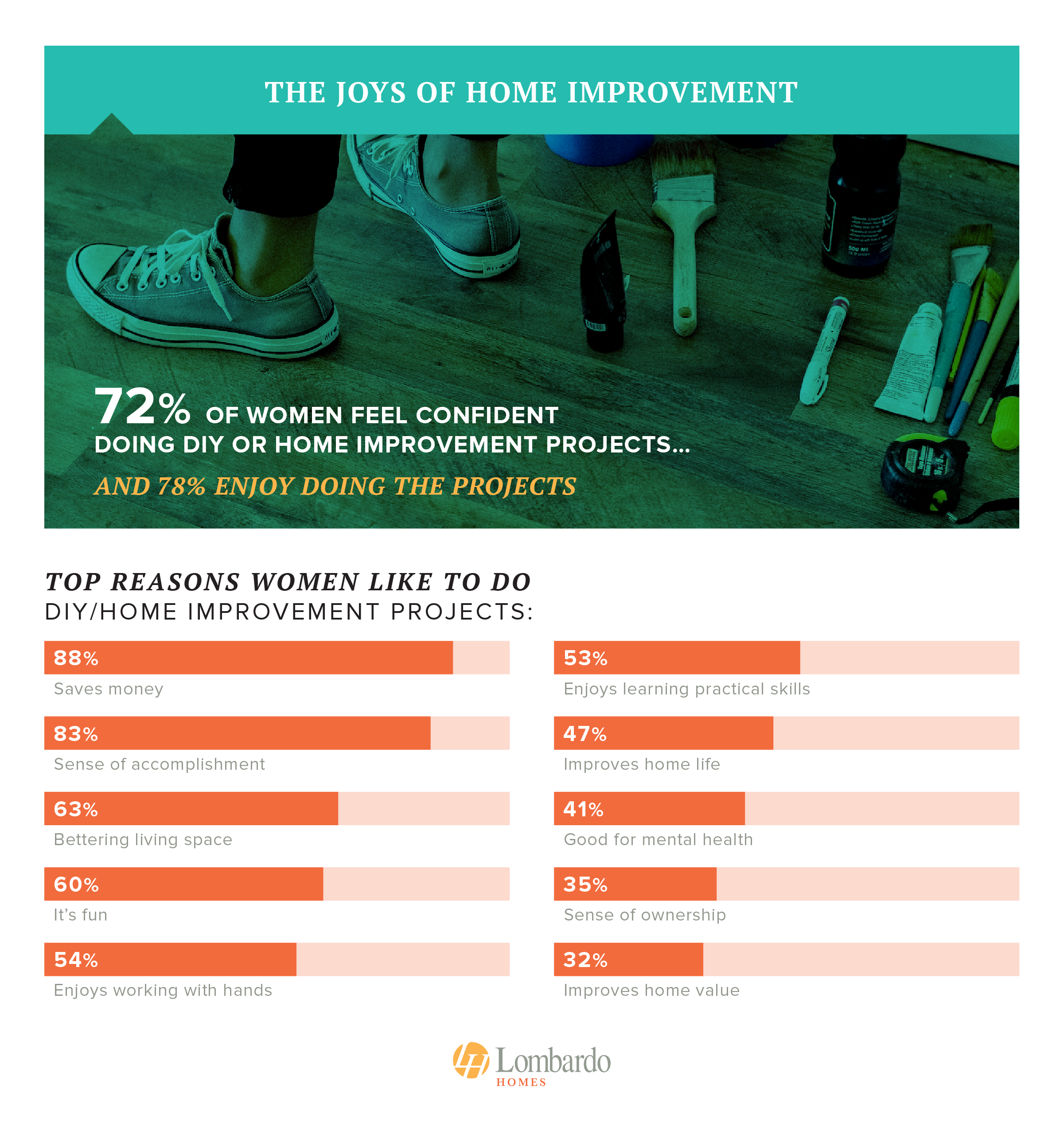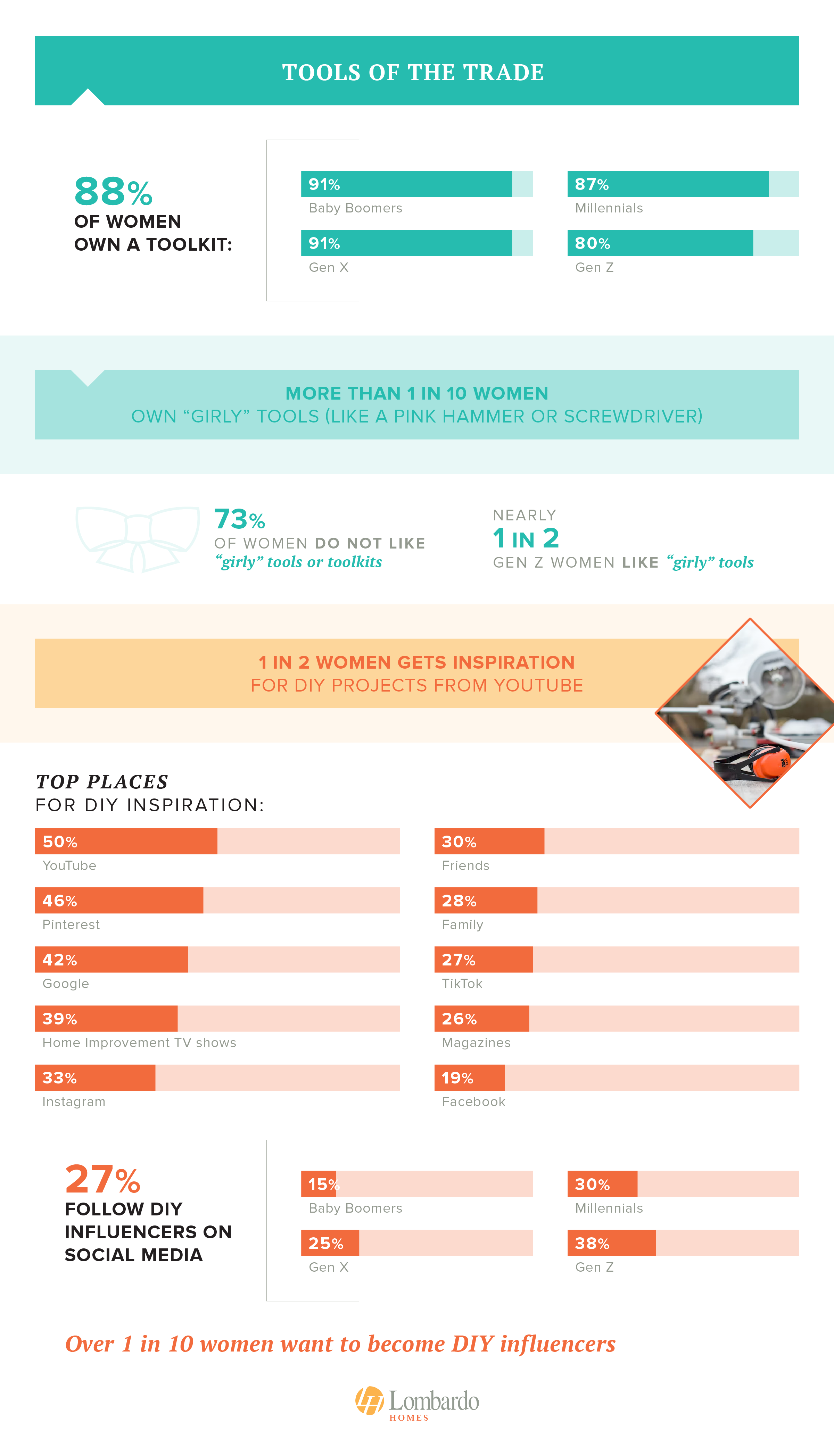
Thanks to the COVID-19 pandemic, more Americans have found themselves becoming home improvement and “do it yourself” (DIY) project gurus. From redecorating to more ambitious renovations or construction – even from scratch– people are giving HGTV a run for its money! Women are increasingly taking the lead in the DIY sphere: but do they feel accepted in these traditionally male-dominated spaces?
We surveyed over 900 women on their habits and preferences on DIY and home improvement projects as well as how they navigate home improvement stores, work with partners, and use contractors.

No DIY project is complete without a trip to the local hardware store or home improvement store; over 9 in 10 women visit home improvement stores as part of their home improvement process.
For many women, it’s a mixed experience: 1 in 10 don’t feel comfortable navigating large stores by themselves. This might be because 2 in 5 feel they are treated differently than men by employees, and 1 in 5 have felt judged asking for help. 16% have even been made to feel stupid when asking for help.
Yet 71% still prefer going to hardware stores as opposed to ordering supplies online, though over 3 in 5 trust online reviews more than hardware store employees.
Another part of the DIY process in many cases is working with contractors hired to do work on-site. Nearly 2 in 5 (39%) women have worked with contractors. Of those, 3 in 5 felt treated differently by contractors than men, and 27% don’t feel comfortable being home alone with contractors. In fact, 30% have even asked someone to be home with them while contractors are over. Perhaps this is why 63% would prefer to hire women-owned businesses if they had the option.
When women do go to home improvement stores, their favorites include Home Depot, Lowe’s, Menard’s, Ace Hardware, and local stores.

Home improvement projects are popular! 93% of women have completed a DIY project in their homes and spend an average of $2,300 on DIY projects. The top spaces women transform are bedrooms, bathrooms, the kitchen, the living/family room, and the yard. Painting tops the list of popular DIY activities, with 3 in 4 women having painted. Other home improvement projects women like to do include redecorating, replacing fixtures, landscaping, and installing new appliances.
Home repair is also key: most women unclog drains, with 78% saying they do so; other top repairs include fixing or patching a hole in the wall (47%), replacing an appliance (41%), resetting a blown fuse (40%), and replacing a lock (38%).
As far as 2023 DIY resolutions, the most popular projects on tap for this year include painting, redecorating, landscaping, replacing fixtures, and installing new flooring. Additionally, more than 1 in 6 are planning on getting new appliances this year.

The old stereotypes of women staying out of home improvement clearly don’t hold true: 72% of women feel confident doing DIY or home improvement projects– and 78% of them enjoy doing them. Some of the top reasons women enjoy completing these projects include saving money, with nearly 9 in 10 women citing the cost-cutting benefits of DIY. Other top reasons include a sense of accomplishment, bettering their living space, and, as 3 in 5 say– it’s just plain fun! Additionally, over 1 in 2 enjoy working with their hands, as well as learning practical skills.

Sometimes it takes two to do DIY projects, and of those women surveyed who have partners, 69% consider their partners to be handier.
Over 4 in 5 women ask their partners to complete DIY tasks for them, and 1 in 4 women in a relationship dictate which projects will be done. Not only that, but nearly 2 in 5 feel their partner does more work when completing a DIY project. When it comes to supply runs to keep the project going, 69% reported going to home improvement stores as a couple.

Overall, 3 in 5 women consider themselves handy. 60% of single-family homeowners consider themselves handy, while 58% of renters consider themselves handy. On the other hand, 76% of mobile homeowners consider themselves handy.
The top ways women learn new skills include YouTube, with over 3 in 5 using the popular video platform to learn. TikTok is also popular among 1 in 10 women for DIY advice. Sometimes it stays in the family as well: 1 in 2 women learned handy(wo)man skills from their father.
Learning has paid off: 76% can find a stud and patch a wall, while 71% know how to replace a doorknob, 69% can reset a blown fuse, and 51% know how to relight a pilot light.

What DIY project is complete without tools? 88% of women own a toolkit, with 91% of Baby Boomers and Gen Xers owning one. Ownership is slightly lower among the younger generations with 87% of Millennials and 80% of Gen Z women owning a tool kit.
Over 1 in 10 even own “girly” tools, like a pink hammer or a screwdriver. That does not, however, make said tools popular overall: 73% of women don’t like ‘girly’ tools or toolkits. Gen Zers have a different opinion: nearly 1 in 2 favor girly tools.
Inspiration can strike anywhere, but for 1 in 2 women, inspiration comes on YouTube. Other top sources of inspiration include Pinterest, Google, Home Improvement TV shows, and Instagram.
27% follow DIY influencers on social media, including 38% of Gen Z and 30% of Millennials. Baby Boomers and Gen X are less plugged into social media DIY influencers, at 15% and 25% respectively. Influencers, however, still have their appeal: over 1 in 10 women want to become DIY influencers on social media.
All in all, women are taking charge of making the home of their dreams, from basic fixes to full-scale renovations. It seems their place really is in the home, making repairs and creating a domestic space that fits their vision.
Methodology
In January 2023, we surveyed 902 women nationwide to learn more about their preferences and habits around DIY and home improvement projects. Among respondents, ages ranged from 18 to 93 with an average age of 42. The relationship status of respondents broke down to 45% married, 21% in a relationship but not married, 21% single, 9% divorced, 2% separated and 2% widowed.
For media inquiries, please contact [email protected].
Fair Use
When using this data and research, please attribute it by linking to this study and citing https://lombardohomes.com/.